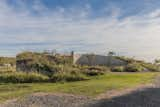How They Pulled It Off: A House Built Into a Hill
Welcome to How They Pulled It Off, where we take a close look at one particularly challenging aspect of a home design and get the nitty-gritty details about how it became a reality.
The project Matias Mosquera calls Shire was born, like so many others, out of the pandemic. His Buenos Aires firm AtelierM was hired by a young couple looking for a change: "During lockdown, they wanted to go to the farm or outside the city, to live more in contact with the earth." The result: their very own gentle hill, rolling up out of the flat Pampas grasslands of Argentina.
"Here in Buenos Aires, it’s really typical to have houses that are like a bar—you walk in one way, you’re in the south, and all the rooms face north," says Mosquera. Instead, AtelierM took that typical layout and bent it like a blacksmith manipulating a piece of metal into a horseshoe. The bedrooms, dining area, and living room grew, maximizing the sweep of their views, while more utilitarian aspects like the walkway, a walk-in closet, and a bathroom fit into the circle’s curve. (Plus a small library.)
At the same time, the architects started to think about getting the family quite literally in contact with the earth—by building the house so that it emerged from the ground. It started with the roof: the outer curve has a slightly higher ceiling, almost three meters tall. The walkway and the inner rooms are more like 2.4 meters.
And then the final touch: they essentially pulled nature over the top of the structure like a blanket. The inside curve of the structure became a round, planted patio, with the front door tucked to the side. And the landscaping extended up and over the sloping southern side of the structure to turn the whole home into a kind of hill. There’s a walkway up the side of the house, to a patio on the roof of the house, with expansive views out across the Pampas.
The whole result has an air of mystery, says Mosquera. Because you can’t see those big windows as you approach the house, the whole structure is a bit of a surprise: "You arrive to the house and you see something that emerges from the ground, but you don’t understand what is happening. You see a round face, a facade, that shows something really small, that seems to be an access. So you suddenly go across this patio with all this vegetation, really wild, and you get inside this house and then the house expands to the views and the good orientation."
"The people are living almost underground," said Mosquera. "Until you get inside the house, you don’t know what is going to happen, because you don’t understand what is going on there." The result lands somewhere between a hobbit hole and a partially disguised spaceship.
How they pulled it off: A house that’s also a hill
- The inner walls of the home are made of rustic, rugged concrete, and to protect against moisture and leaking, they’re two walls—an inner and an outer, with an EPS insulation system in the space between. "It’s like four centimeters of isolation, really thick and really powerful," says Mosquera.
The rainwater captured on the landscaped roof is used for irrigation of the plantings, boosting the property’s self-sufficiency and helping head off any leaks.
The inside curve of the home gets natural light as well, using skylights. There’s a round one in the ceiling of the bathroom, and a long, thin one running over the walkway corridor, creating a feeling of openness.
Project Credits:
Design: AtelierM
Project Team: Matias Mosquera, Camila Gianicolo, Cristian Grasso, Nicolás Krause, Sebastian Karagozlu
Construction Team: Matias Mosquera, Nicolas Krause, Ivon Strk, Francisco Gomez Paratcha
Structural Analysis: Gustavo Carreira
Landscape Design: Carolina Pell
Published
Last Updated
Topics
How They Pulled It OffGet the Dwell Newsletter
Be the first to see our latest home tours, design news, and more.







